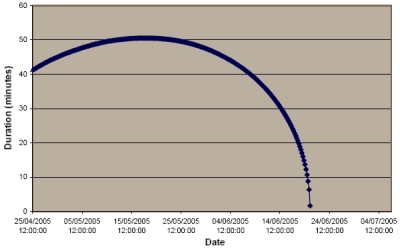No. 39 - SMART-1 Ready for Operations Phase
The OOR Board main conclusion is repeated hereafter: "The Board concludes that, except for the lack of demonstration of commissioning of the scientific instruments, all other objectives of the Smart-1 Operational Orbit Review (OOR) have been achieved and that the mission is ready to enter in the operation phase. The scientific instruments commissioning issue should be tackled as the highest priority of all registered actions of this review to make sure that the data take, currently performed with these instruments, are made with the right parameter settings to allow their exploitation later."
Future activities
- Final decision on Orbit reboost for possible mission extension
- Science Operations
Spacecraft Status
AOCS
The spacecraft has been in Moon nadir-pointing attitude during the entire orbit and period, except for periods when the MGA antenna was pointed to Earth for data download purposes.
Eclipses
Over the reporting period the lunar eclipse lengths have steadily increased from 39 minutes on 25 April to 49 minutes on 15 May. There have been 102 lunar eclipses to date.
 |
|
Predicted duration of Eclipses for 25 April - 20 June 2005 |
Instrument Status
SMART-1 payload commissioning sequences were run in April. As expected the instruments performances are very sensitive to the thermal conditions in Lunar orbit. Therefore specific operating conditions have been arranged to limit the exposure of the panel supporting the SIR and D-CIXS instruments.
These conditions also constrain the downlink pointing to Earth, especially around new moon, as the remote sensing payload are mounted on the opposite side of the spacecraft from the communication medium gain antennas.
SIR
The SIR experiment has conducted a pointing of Jupiter to refine the wavelength calibration. Observations made of the Moon show differences of infrared reflectance between highlands and maria.
D-CIXS
Data obtained by D-CIXS during a solar flare allowed for the first time the detection from orbit of the Calcium element on the Moon. The operating parameters had to be fine-tuned to adapt to the thermal conditions of the spacecraft and instrument.
Orbital Information
|
SMART-1 OD317 – Close to Apolune 606 | |
| Pericentre Distance (km) | 2291.250200 |
| Apocentre Distance (km) | 4515.857486 |
| Semi Major Axis (km) | 3403.553843 |
| Eccentricity | 0.326807 |
| Inclination (°) | 89.734929 |
| Ascending Node (°) | 236.970851 |
| Argument of Pericentre (°) | 264.808942 |
| True Anomaly (°) | 180.000002 |
| Osculating Orbital Period (h) | 4.949919 |
The changes since apolune 504 are as follows:
- Semi-major axis: -0.1 km
- Perilune height: +7.5 km
- Apolune height: -7.3 km
- Orbital period: +0.0 min
